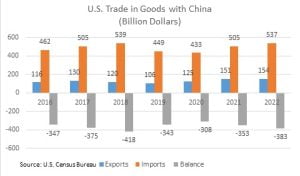Share This Article
Disintegration Tendencies in Global Trade and Investment: A Critical Look at the Role of the US
by Gülsüm Akbulut
The COVID -19 pandemic has increased fragmentation trends in the global economy, leading to disruptions in global supply chains and an increase in protectionism and trade restrictions. Protectionist policies initiated by the Obama administration have been continued by the Trump administration, which has waged a technology and trade war against China. The Biden administration’s extensive measures to promote the production of key imported goods in the United States have further fueled the decoupling trend in the global economy. In addition, the sanctions imposed on Russia have contributed to the process of economic fragmentation, which will be assessed separately.
The Trump administration’s concern over dependence on Chinese products led to the imposition of tariffs on certain Chinese products in 2018, triggering retaliatory tariffs from China and escalating the trade war between the two nations. The import restrictions imposed by the U.S. did not immediately reduce the U.S. trade deficit, as there were no viable alternatives for U.S. producers for many Chinese products. As a result, the U.S. trade deficit with China reached a record high of $418 billion in 2018. (Figure 1) Nevertheless, U.S.-China trade restrictions continued and new measures added to encourage the production of key imported goods in the country. As a result, U.S. import tariffs revenues increased from about 7 percent of total imports in 2016 to 18 percent in 2022. (Figure 2)
The United States has imposed various restrictions on Chinese companies, particularly in the technology sector, beginning during the Obama administration and continuing under Trump and Biden. The restrictions were primarily aimed at slowing China’s technological progress and protecting national security interests. One of the most notable cases is the controversy surrounding Chinese technology company Huawei.[1] In 2018, the U.S. barred government agencies from purchasing Huawei equipment and services due to concerns about Huawei’s close ties to the Chinese government. In 2019, the U.S. placed Huawei on the Entity List and prohibited the company from purchasing products and services from U.S. companies without prior U.S. government approval and imposed restrictions on the export and transfer of U.S. goods to Huawei. Similarly, in 2020, the Trump administration wanted to ban the Chinese-owned apps TikTok and WeChat, which were used by 100 million people in the United States. While the Biden administration did not implement this decision, it acknowledged concerns about these software apps and directed federal agencies to investigate data security issues. The government also blocked TikTok for all government-issued mobile devices[2]. The evolution of these restrictions on Chinese technology investment is an important area of research because it has significant implications for U.S.-China relations, technological progress, and global trade.
The United States has taken various subsidy and support measures to encourage the production of certain commodities within its borders. This has led to increasing tensions among countries competing for these commodities, including European countries. In August 2022, the Biden Administration introduced the Inflation Reduction Act[3] and the CHIPS and Science Act[4], which have attracted the attention of countries around the world.
The Inflation Reduction Act was introduced in response to rising inflation rates in the United States, which reached 9.2 percent in June 2022, the highest level since 1981. [5] The Act aims to reduce inflation, encourage domestic manufacturing and energy production, and reduce carbon emissions. Among others, the Act provides large subsidies totaling $369 billion over the next decade for energy security and climate change initiatives, with the caveat that the subsidies will be provided if the goods are made in the U.S. and consist primarily of American parts.
Similarly, the CHIPS and Science Act aims to boost domestic manufacturing and supply chains in key industries such as nanotechnology, clean energy, quantum computing, and artificial intelligence. The Act provides a 25 percent tax credit for investment in semiconductors and related devices and allocates $52.7 billion for research, development, manufacturing, and workforce development in the U.S. semiconductor industry. It is intended to encourage strategic investments to ensure U.S. competitiveness in key areas. This includes incentives for private companies to build semiconductor factories in the United States.
However, European countries and EU officials have expressed concerns about the potential impact of these measures on their respective economies. The subsidies and tax breaks offered by the Inflation Reduction Act could create incentives for European companies to relocate to the United States, further hurting industrial production and jeopardizing investment in the green transformation in Europe. In response, Germany has stressed the need for more flexible state aid law for investments in renewable energy or decarbonizing industries.[6]
The trade and subsidy measures and the imposition of certain sanctions by the Trump administration and their continuation under the Biden administration have raised concerns about their compatibility with WTO rules and their potential impact on international trade and investment. Counterpart responses are accelerating market fragmentation and exacerbating protection. The International Monetary Fund (IMF) estimates that the total number of restrictions on goods, services, and investment has increased significantly and is four to five times higher in 2021 than in 2013. The IMF has warned that these restrictions, combined with technological decoupling, could reduce global GDP by up to 7 to 12 percent[7].
The imposition of trade protections and subsidies on domestic production by the Trump and Biden administrations has been identified as a major obstacle to the creation of a liberal trade order that the United States has long sought. This has led countries to express growing concern about the potential negative impact of these measures on the international trading system and national economies.
Gülsüm Akbulut
Director of Global and Turkish Economic Studies
13 March 2023
Figure 1: The U.S. Trade with China

Figure 2: The US Imports and Revenues on Import Duties

[1] https://www.scmp.com/tech/tech-war/article/3130587/us-china-tech-war-everything-you-need-know-about-us-china-tech-war
[2] https://www.pbs.org/newshour/politics/why-tiktok-is-being-banned-for-some-federal-employees
[3] https://www.democrats.senate.gov/imo/media/doc/inflation_reduction_act_one_page_summary.pdf
[4]https://www.whitehouse.gov/briefing-room/statements-releases/2022/08/09/fact-sheet-chips-and-science-act-will-lower-costs-create-jobs-strengthen-supply-chains-and-counter-china/
[5] https://www.usinflationcalculator.com/inflation/historical-inflation-rates/
[6] https://www.euractiv.com/section/politics/news/germany-under-fire-for-push-to-revamp-eu-subsidy-rules/
[7] https://www.imf.org/en/Blogs/Articles/2023/01/16/Confronting-fragmentation-where-it-matters-most-trade-debt-and-climate-action

